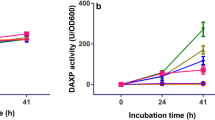Abstract
Cellulomonas strains consumed commercial cellulose, cellulosic residues, xylan, cellobiose and carboxymethyl cellulose (CMC) as carbon sources in liquid culture, the growth being the most on cellobiose medium. All three components of the cellulase complex ofCellulomonas were produced when the organisms utilized all substrates as sole carbon and energy sources. The filter-paper cellulase (FPase) and endo-glucanase (CMCase) activities were higher in media containing α-cellulose and cellulosic residues than in media containing CMC, cellobiose, and xylan. Cell-free supernatants of all organisms exhibited greater CMC hydrolyzing activity than filter paper and β-glucoside hydrolyzing activities. All strains synthesized β-glucosidase maximally on cellobiose followed by commercial cellulose and cellulosic residues.C. biazotea produced the highest FPase and CMCase activity during growth on α-cellulose. It was followed byC. flavigena, C. cellasea, andC. fimi. Endo-glucanase and FPase from all organisms were secreted into the medium; 10–13 % became adsorbed on the surface of the insoluble substrates and could be successfully eluted using Tween 80. β-Glucosidase was located in cell extracts from all organisms.C. biazotea produced FPase and β-glucosidase activities several-fold greater than those produced by many other strains ofCellulomonas and some other cellulolytic bacteria and fungi.
Similar content being viewed by others
References
Azad M.I.: Recycling of organic matter. Fortnightly issue, “Zirat Nama Supplement” January 15th, 1986. Ayub Agriculture Research Institute, Faisalabad 1986.
Bahkali A.H.:In vitro production of proteolytic and cellulolytic enzymes byColletotrichum lindemuthianum isolated from soyabean grown in Saudi Arabia.World J.Microbiol.Biotechnol. 8, 55–59 (1992).
Barron A., May G., Berner E., Villarejo M.: Regulation of envelope protein composition during adaptation to osmotic stress inEscherichia coli.J.Bacteriol. 167, 433–438 (1986).
Beguin P.: Molecular biology of cellulose degradation.Ann.Rev.Microbiol. 44, 219–248 (1990).
Deshpande V., Ericksson K.E.: 1,4-β-Glucosidases ofSporotrichum pulverulentum.Methods Enzymol. 160, 415–424 (1988).
Duenas R., Tengerdy R.P., Gutierrez-Corea M.: Cellulase production by mixed fungi in solid-substrate fermentation of bagasse.World J.Microbiol.Biotechnol. 11, 333–337 (1995).
Haggett K.D., Gray P.P., Dunn N.W.: Crystalline cellulose degradation by a strain ofCellulomonas and its mutant derivatives.Eur.J.Appl.Microbiol.Biotechnol. 6, 183–190 (1978).
Hrmova M., Petrakova E., Biely P.: Induction of cellulose and xylan-degrading enzyme systems inAspergillus terreus by homo- and hetero-disaccharides composed of glucose and xylose.J.Gen.Microbiol. 137, 541–547 (1991).
Kubicek C.P., Messner R., Guber F., Mach R.L., Kubicek-Pranz E.M.: TheTrichoderma cellulase regulatory puzzle: From the interior life of a secretory fungus.Enzyme Microb.Technol. 15, 90–99 (1993).
Latif F., Rajoka M.I., Malik K.A.: Saccharification ofLeptochloa fusca (kallar grass straw) by thermostable cellulases.Biores.Technol. 50, 107–112 (1994).
Lin E., Wilson D.V.: Regulation of β-1,4-endoglucanase synthesis inThermomonospora fusca.Appl.Environ.Microbiol. 53, 1352–1357 (1987).
Marsden W.L., Gray P.P.: Enzymatic hydrolysis of cellulose in lignocellulosic materials.CRC Crit.Rev.Biotechnol. 3, 235–276 (1986).
Milagres A.M.F., Lacis L.S., Prade R.A.: Characterization of xylanase production by a local isolate ofPenicillium janthinellum.Enzyme Microb.Technol. 15, 248–253 (1993).
Miller G.L.: Use of dinitrosalicylic acid (DNS) for determination of reducing sugars.Anal.Chem. 31, 426–428 (1959).
Nakamura K., Kitamura K.: Cellulases ofCellulomonas uda.Methods Enzymol. 160, 211–216 (1988).
Nakamura K., Kitamura K.: Isolation and identification of crystalline cellulose hydrolyzing bacterium and its enzymic properties.J.Ferment.Technol. 60, 343–348 (1982).
Nochure S.V., Roberts M.F., Demain A.L.: True cellulase production byClostridium thermocellum grown on different carbon sources.Biotechnol.Lett. 15, 641–646 (1993).
Pirt S.J.:Principles of Cell Cultivation, pp. 5, 7, 8, 159. Blackwells Scientific, London 1975.
Rajoka M.I.: Bioconversion of lignocellulosic materials raised from saline lands for production of biofuels usingCellulomonas species (as cellulolytic organisms).PhD Thesis. University of the Punjab, Lahore (Pakistan) 1990.
Rajoka M.I., Malik K.A.: Comparison of different strains ofCellulomonas for production of cellulolytic and xylanolytic enzymes from biomass produced on saline lands.Biotechnol.Lett. 8, 557–560 (1986).
Rajoka M.I., Malik K.A.: Cellulase and hemicellulase production byCellulomonas flavigena NIAB 441.Biotechnol.Lett. 6, 597–601 (1984).
Ryu D.D.Y., Mandels M.: Cellulases: Biosynthesis and application.Enzyme Microb.Technol. 2, 91–102 (1980).
Shirlaw D.W.G.:A Practical Course in Agriculture Chemistry, pp. 122–131. Pergamon Press, USA 1969.
Stoppok W., Rapp P., Wagner F.: Formation, location and regulation of endo-1,4-β-glucanase and β-glucosidase fromCellulomonas uda.Appl.Environ.Microbiol. 44, 44–53 (1982).
Thomson J.A.: Molecular biology of xylan degradation.FEMS Microbiol.Rev. 104, 65–82 (1993).
Waldron C.R. Jr.,Becker C.A., Vallone A., Eveleigh D.E.: Isolation and characterization of a cellulolytic actinomyceteMicrobispora bispora.Appl.Microbiol.Biotechnol. 24, 477–486 (1986).
Author information
Authors and Affiliations
Additional information
These studies were supported byPakistan Atomic Energy Commission. Some chemicals were purchased from funds allocated byUnited States Agency for International Development, Washington (DC, USA), under PSTC proposal 6.163.
Rights and permissions
About this article
Cite this article
Rajoka, M.I., Malik, K.A. Enhanced production of cellulases byCellulomonas strains grown on different cellulosic residues. Folia Microbiol 42, 59–64 (1997). https://doi.org/10.1007/BF02898647
Received:
Revised:
Issue Date:
DOI: https://doi.org/10.1007/BF02898647




